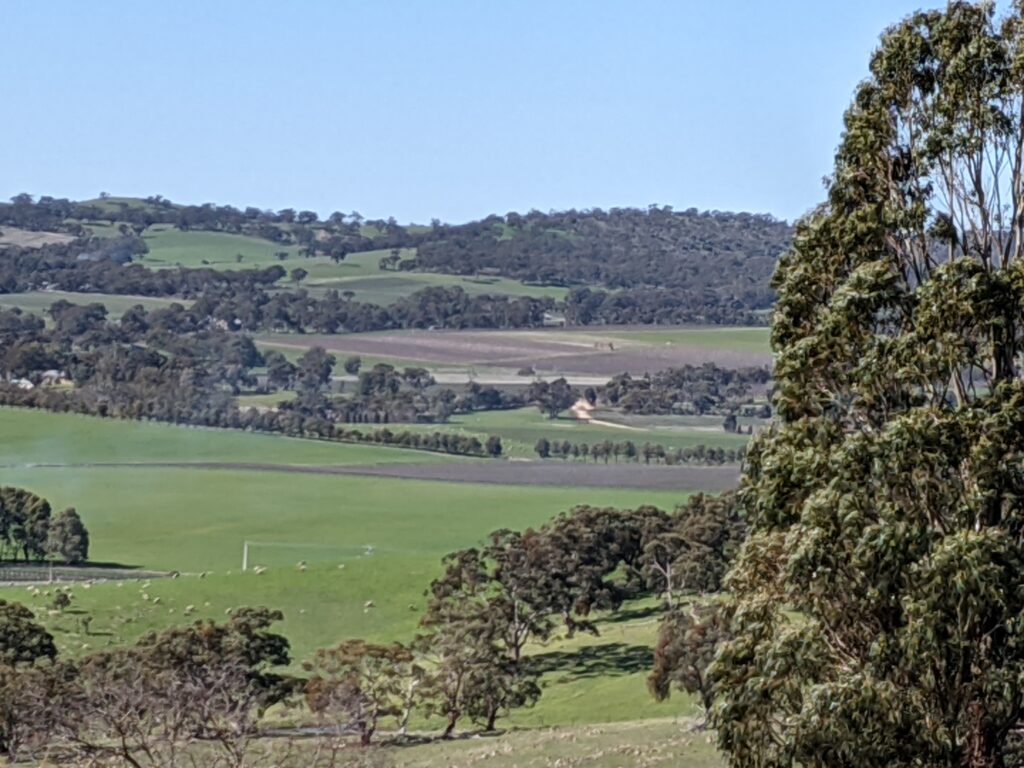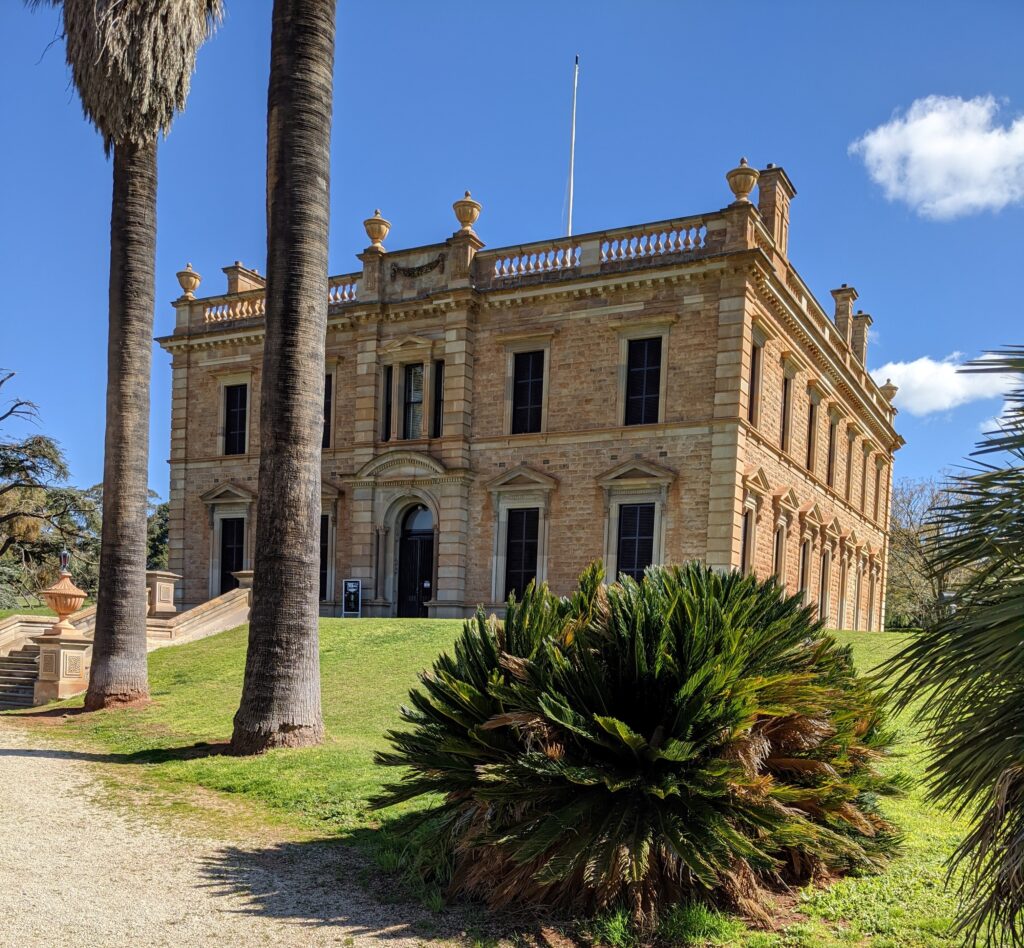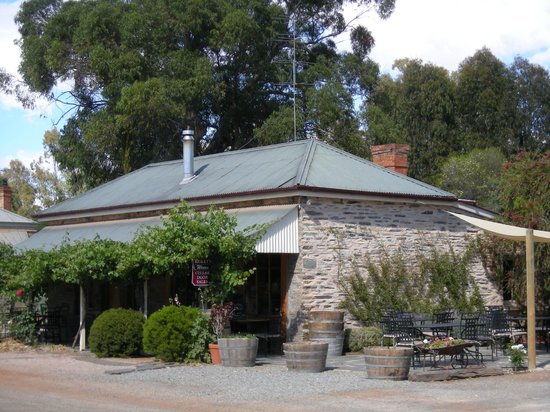Only eleven kilometres off the Horrocks Highway that sprints through the Clare Valley, Mintaro is a tiny, rural village that has been tucked into the hills since Adelaide was a toddler. In 1984 it was declared a State Heritage site, and for good reason. I am delighted to think we know how to protect some of our historic treasures.
A centre for slate mining, Mintaro village has been largely constructed from this hardy stone. Any modern alterations, renovations or even new builds must be in keeping with the character of the originals. If not for the passing cars – and these are few and far between on a quiet Friday afternoon in August – it is like entering a time warp.
It is also a far cry from the dry, dusty mid north I have visited before. After a wondrously wet winter, the countryside is unfamiliar to me in its verdant winter coat. I find myself smiling in delight at every turn in the road, every panoramic view from the crest of a hill. Plump lambs dance in paddocks carpeted in deep green grass. Flocks of gossiping galahs with their raspberry vests, provide a vibrant contrast. For once, the scattering of gum trees look alert and happy, not defeated by the long, hot summers.
Mintaro was initially a busy staging point for transporting copper from Burra to Port Wakefield in the 1840’s, the Magpie and Stump a popular watering hole with the bullock drivers trudging nine miles a day from Burra to the coast. In the 1850s, many deserted Burra for the more lucrative gold mines in Victoria and New South Wales, so the mining company began seducing South American miners and muleteers to fill the gap. By the 1860s Mintaro had struck gold itself – well, slate at least – and soon the local quarries were producing slate of some of the highest quality in the country, which it continues to mine and export today.
The Gilbert Valley is also a fertile farming district, producing wheat, wool and wine which have created wealth for local farmers over the centuries. Only three kilometres out of town, Martindale Hall stands in all its rather pretentious glory, a pocket-sized Downtown Abbey that once boasted a cricket pitch, a boating lake, a polo ground and a race track. £30,000 was spent importing marble tradesmen and furniture from Europe to create all this splendour. Yet sadly, such ostentatious wealth did nothing to ensure a happy life for any of its owners. In fact, the history of Martindale is surprisingly tragic.
The Bowman family grew from sheep farmers in the north of England to wealthy landowners in two generations. They made their money on the back of the sheep, first as pioneer pastoralists in Tasmania, among chains and convicts, later as landowners in the free province of South Australia. In the mid nineteenth century, Edmund Bowman Snr. established a successful merino stud on 9,000 acres in the Gilbert Valley. He also bred racehorses. But he drowned in the Wakefield River when his eldest son was still a boy.
Edmund Junior was educated at Cambridge University. He returned home to an inheritance large enough to recreate a slice of Georgian England in the Australian bush where he entertained lavishly. He named it Martindale Hall after a pretty valley near the family’s original home in Cumbria. A renowned polo player, he had little more than a decade to enjoy his glamorous lifestyle. Beleaguered by drought and falling wool prices, and financially over-extended, he was forced to sell up in 1891. He died in Adelaide at 66, after a long illness.
The Martindale Estate was then bought by William Tennant Mortlock, a South Australian politician and grazier. Also educated at Cambridge, he came home to marry his first cousin, Rosina Tennant. They had six children – five sons and a daughter – but three did not survive infancy. Their oldest son, Valentine, was born with cretinism and was hidden from the world in an upstairs bedroom until he died at the age of eight. His ghost has apparently been seen several times since, most recently in 2011 by a young visitor who thought he was a girl with his long blond locks. His small room, once gated, made my skin prickle, and I avoided looking in the old mirror above the fireplace. The influence of too many horror movies in my youth I suspect! William himself died aged only 55 when his two remaining sons were teenagers. One of these young men would later die in Colombo.
Jack, now the oldest son and heir, travelled widely – perhaps to escape from the family ghosts – and his collection of memorabilia grace the smoking room walls. He did not marry until he was 54, only to die fifteen months later. His wife lived on at Martindale Hall until 1965, when, according to her husband’s wishes, she handed it over to Adelaide University. It is now in the hands of the SA government, in trust for the people of South Australia.
Escaping from the gloomy, ghost ridden rooms of Martindale Hall, I drove back to town. Here, I found a much happier story in the middle of Mintaro, just across the road from the Magpie and Stump, the local pub. This pub has been around since Noah was a babe – well, almost – and here, the One & Only was spending the weekend being creative with lino cut and paint. Before crossing the road to Reilly’s winery, I soaked up the early spring sunshine for a while, lounging peacefully in the pub’s large garden, enjoying two cups of excellent coffee.
Reilly’s winery was established in 1993 by South Australian entrepreneurs Justin and Julie Ardill. The cellar door can be found in a beautiful slate cottage, built in 1856 by Hugh Reilly. Reilly was a shoemaker from Ireland, who established his family and a saddlery in the small town, and for whom the winery is named.
We had wandered in the day before, looking for lunch. Annette, the chef here for several years, provided us with a sumptuous platter of local olives and mettwurst, Reilly’s own chutney and dukkha, a perfect piece of steak, a homemade fishfinger in crispy batter, a divine little roast vegetable tart and two glasses of wine. The One & Only chose white: an aged Riesling (more to my taste than his, with its oaked butteriness reminiscent of those original Chardys), and the 2018 Watervale Riesling, which won the Travelrite trophy for Riesling of the year in 2019. Meanwhile, I indulged in a glorious grenache and a lighter but meaty tempranillo.
Later that afternoon, I popped in to taste other wines. Justin has had great fun experimenting with all sorts of grape varieties and wine styles. And I had great fun tasting them! My particular favourites were the Old Bush Vine Grenache and the Copper Ox Shiraz, named in honour of the sure and steady oxen that pulled the wagons coming from the copper mines to the northwest. With grapes picked from 90 year old vines, its juices aged in oak, this glorious wine slides over the tongue like a deep-throated song, whispering of aniseed, mocha and deep red berries. The Grenache grapes come from even older vines, planted just after WWI, that grow close to the ground and require (flexible) hand picking. Peppery, with touches of liquorice and cherry, this lovely wine is aged in oak for two years, from which it benefits greatly, and showing off a long and elegant finish. A bright and flavourful Rosé or Saignée (literally bleeding) will be a perfect, chilled accompaniment to a summer afternoon in the garden – unless you prefer bubbles when you should reach for the cuvée Shiraz. The One & Only went merrily down the Riesling road, with a slight detour through the cabernet sauvignons. We left with some extra bottles of our favourites, including a rich Blue Tongue Tawny Port and the Cane Cut Riesling. Sporting luscious flavours of honey and marmalade, a cheeky dash of lime cuts this dessert wine’s somewhat cloying sweetness down a notch. And just in case you have sipped too many wines to contemplate the drive home, the Ardills own a selection of B&B cottages only a step or two down the road.And on that note, I’m signing off to drive back to our campsite, a pasta sauce we prepared earlier, and another glass of Grenache. Salut!



